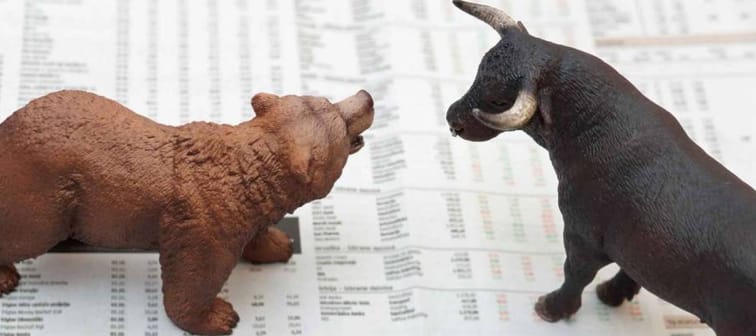What is a bear market?
The term “bearish” is usually given to markets that fall 20% or more from recent highs and threaten to keep falling.
Investors in a bull market feel confident enough to buy in, because they expect the value of their investments to rise. On its own, that demand helps drive prices up.
Bear markets occur when people expect things will get worse and sell in order to mitigate their losses. That drives prices down, inspiring more pessimism. The cycle can continue for years until a market correction happens.
A slump in the overall economy can help trigger a bear market. High unemployment leading to low consumer spending and poor profits are all bad signs that the value of publicly traded companies will stop increasing.
Sometimes a major government decision or global crisis, like the COVID-19 pandemic, is to blame. In March 2020, the Dow Jones Industrial Average — which measures the stock performance of 30 large companies in the U.S. — dropped by 12.9% in a single day.
More recently, spiking inflation — along with the Fed's ongoing efforts to tame that inflation — has sent global markets on a roller coaster ride.
Meet Your Retirement Goals Effortlessly
The road to retirement may seem long, but with WiserAdvisor, you can find a trusted partner to guide you every step of the way
WiserAdvisor matches you with vetted financial advisors that offer personalized advice to help you to make the right choices, invest wisely, and secure the retirement you've always dreamed of. Start planning early, and get your retirement mapped out today.
Get StartedWorst bear markets in history
Here are some of the worst bear markets in U.S. history prior to the COVID-19 pandemic.
The Great Depression
This is the big one. The Dow dropped by almost 90% between September 1929 and July 1932.
Initial dips in the market, due to a number of external factors, triggered a cascade of panicked selling, resulting in a full-blown stock market crash. Many people had borrowed money to buy stocks and were ruined when their investments tanked.
The 2008-2009 Financial Crisis
This bear market kicked off with the biggest single-day market drop in history to that point. On Sept. 29, 2008, the Dow Jones fell 777.68 points.
Again, too many people were taking out loans they couldn’t afford — this time inspired by lax lending standards. The banks and investment firms that participated started to fail, requiring massive government bailouts.
It took until March 2013 for the Dow to reach the heights of 2007 again.
The 1973 Bear Market
This market decline is often attributed to a series of government reforms, including President Richard Nixon’s decision to end the gold standard.
Between January 1973 and December 1974, the Dow Jones lost over 45% of its value.
How do investors take advantage of a bear market?
The risk of investing in a bear market is that share prices are likely to continue dropping in the immediate future. You can always reach new lows, and there’s no guarantee that the market will turn bullish again soon.
One strategy is to look at conservative investments that aren’t as exposed to economic fluctuations, such as government bonds.
However, buying stocks in a bear market isn’t a bad idea, provided you have time. If you’re not retiring for 10, 15, 20 or 25 years, then a bear market offers an opportunity to acquire what would’ve been an expensive portfolio for much less.
If you’re not sure what you should do, you might want to consult a certified financial planner who can map out the years ahead, based on your income and goals.
Or, if you’d rather go it alone, you can try out a robo-advisor. Once you’ve laid out your investment timeline and your tolerance for risk, a series of sophisticated algorithms will design a portfolio for you. Your robo-advisor will then make regular adjustments depending on what’s happening in the market.
Dollar-cost-averaging (DCA) is another strategy you could use. With DCA, you pick an amount of money you want to invest every month and pay no attention to the price of shares and how many you’re buying. When they’re cheap, you get to buy more, and when they’re expensive, you end up buying less.
If the idea of investing in a bear market makes you nervous, you can always get started with a small amount of money. Micro-investing apps like Acorns allow you to buy in with your spare change by rounding up your purchases to the nearest dollar and investing the difference.
Sponsored
Follow These Steps if you Want to Retire Early
Secure your financial future with a tailored plan to maximize investments, navigate taxes, and retire comfortably.
Zoe Financial is an online platform that can match you with a network of vetted fiduciary advisors who are evaluated based on their credentials, education, experience, and pricing. The best part? - there is no fee to find an advisor.







